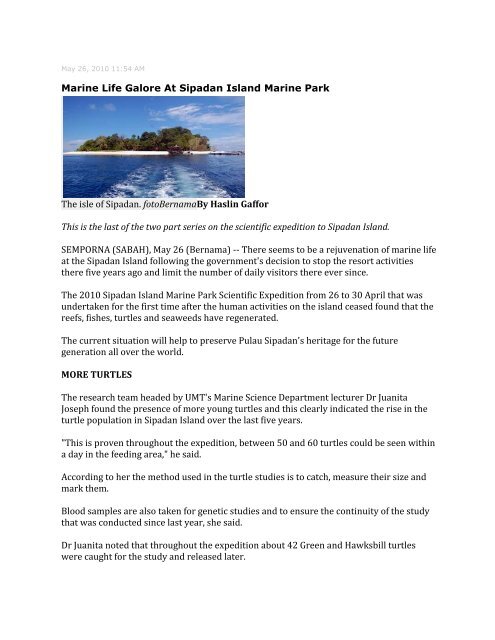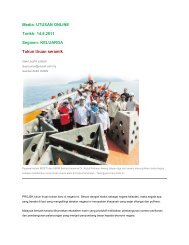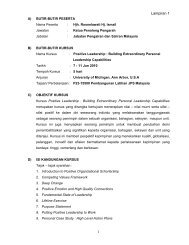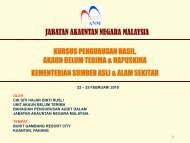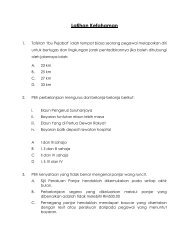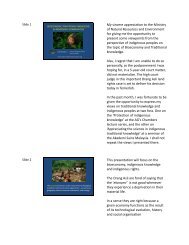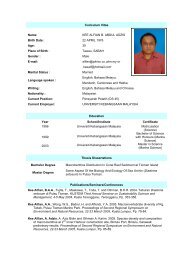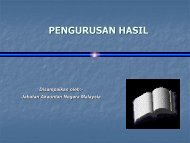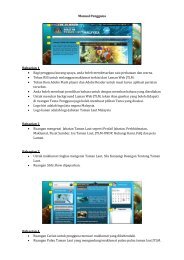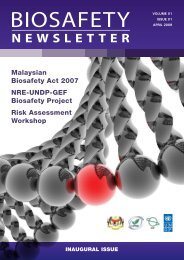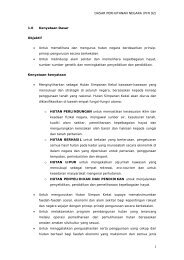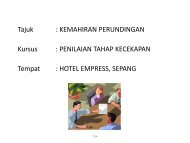Marine Life Galore At Sipadan Island Marine Park The isle of ...
Marine Life Galore At Sipadan Island Marine Park The isle of ...
Marine Life Galore At Sipadan Island Marine Park The isle of ...
Create successful ePaper yourself
Turn your PDF publications into a flip-book with our unique Google optimized e-Paper software.
May 26, 2010 11:54 AM<br />
<strong>Marine</strong> <strong>Life</strong> <strong>Galore</strong> <strong>At</strong> <strong>Sipadan</strong> <strong>Island</strong> <strong>Marine</strong> <strong>Park</strong><br />
<strong>The</strong> <strong>isle</strong> <strong>of</strong> <strong>Sipadan</strong>. fotoBernamaBy Haslin Gaffor<br />
This is the last <strong>of</strong> the two part series on the scientific expedition to <strong>Sipadan</strong> <strong>Island</strong>.<br />
SEMPORNA (SABAH), May 26 (Bernama) -- <strong>The</strong>re seems to be a rejuvenation <strong>of</strong> marine life<br />
at the <strong>Sipadan</strong> <strong>Island</strong> following the government's decision to stop the resort activities<br />
there five years ago and limit the number <strong>of</strong> daily visitors there ever since.<br />
<strong>The</strong> 2010 <strong>Sipadan</strong> <strong>Island</strong> <strong>Marine</strong> <strong>Park</strong> Scientific Expedition from 26 to 30 April that was<br />
undertaken for the first time after the human activities on the island ceased found that the<br />
reefs, fishes, turtles and seaweeds have regenerated.<br />
<strong>The</strong> current situation will help to preserve Pulau <strong>Sipadan</strong>'s heritage for the future<br />
generation all over the world.<br />
MORE TURTLES<br />
<strong>The</strong> research team headed by UMT's <strong>Marine</strong> Science Department lecturer Dr Juanita<br />
Joseph found the presence <strong>of</strong> more young turtles and this clearly indicated the rise in the<br />
turtle population in <strong>Sipadan</strong> <strong>Island</strong> over the last five years.<br />
"This is proven throughout the expedition, between 50 and 60 turtles could be seen within<br />
a day in the feeding area," he said.<br />
According to her the method used in the turtle studies is to catch, measure their size and<br />
mark them.<br />
Blood samples are also taken for genetic studies and to ensure the continuity <strong>of</strong> the study<br />
that was conducted since last year, she said.<br />
Dr Juanita noted that throughout the expedition about 42 Green and Hawksbill turtles<br />
were caught for the study and released later.
On the number <strong>of</strong> turtles that land to lay eggs around <strong>Sipadan</strong> <strong>Island</strong>, Dr Juanita noted that<br />
it is still too early to decide as there is no complete data recorded since last year for<br />
comparison purposes.<br />
He said, the gazetting <strong>of</strong> <strong>Sipadan</strong> <strong>Island</strong> as a park under the care <strong>of</strong> Sabah <strong>Park</strong>s has<br />
provided the turtles a protected habitat and allowed their population to increase.<br />
<strong>The</strong> expedition this time managed to record new species <strong>of</strong> seaweeds.<br />
Irwan Isnain from Sabah <strong>Park</strong>s who is leading the research noted that, the seaweed<br />
covered waters around the island is really vast and it extends to the reefs and attracts<br />
turtles to feed.<br />
FISH POPULATION INCREASES<br />
In this expedition too, the fish researchers found two species <strong>of</strong> the threatened Humphead<br />
Wrasse and Humphead Parrotfish, known as 'Maming' and 'Kat' respectively in the local<br />
language thriving at the waters <strong>of</strong> <strong>Sipadan</strong> <strong>Island</strong> National <strong>Park</strong>.<br />
Dr Mabel Manjaji from UMS found overwhelming numbers <strong>of</strong> coral grouper a clear<br />
indication <strong>of</strong> a healthy coral ecosystem.<br />
<strong>The</strong> presence <strong>of</strong> schools <strong>of</strong> Barracuda, Jackfish and Humphead Parrotfish point out that<br />
things are better now compared with five years ago.<br />
"By limiting the number <strong>of</strong> divers in the island waters, the fishes have returned to<br />
<strong>Sipadan</strong>," noted Dr Mabel.<br />
REEFS ARE HEALTHY<br />
<strong>The</strong> presence <strong>of</strong> the fishes at the waters <strong>of</strong> Pulau <strong>Sipadan</strong> is also due to the healthier reefs<br />
now compared with five years ago.<br />
<strong>The</strong> reef researchers in this expedition headed by Daud Awang from the Malaysian<br />
Fisheries Department found that since five years ago many juvenile or individual reefs<br />
have emerged.<br />
He proposed to Sabah <strong>Park</strong>s to monitor diving activities around the waters <strong>of</strong> <strong>Sipadan</strong><br />
<strong>Island</strong> to ensure there is no damage to the reefs.<br />
Studies also indicate that the reefs are rich in algae.<br />
Dr Normawaty Mohd Noor from UMS who studied the algae pointed out that the algae<br />
serves as the water quality indicator and their diverse presence is certainly a thumbs up<br />
for the environment here.
<strong>The</strong> high species diversity points that the natural environment in Pulau <strong>Sipadan</strong> is in good<br />
condition.<br />
<strong>The</strong> 2010 <strong>Sipadan</strong> <strong>Island</strong> <strong>Marine</strong> <strong>Park</strong> Scientific Expedition has met its objective to check<br />
on the marine life at the <strong>Sipadan</strong> <strong>Island</strong> <strong>Marine</strong> <strong>Park</strong> that has witnessed the rejuvenation <strong>of</strong><br />
nature since all human activities ceased on the island.<br />
-- BERNAMA


